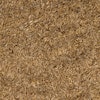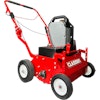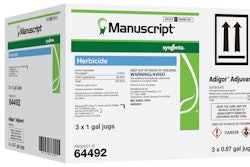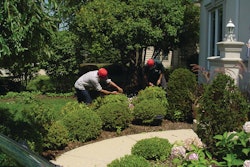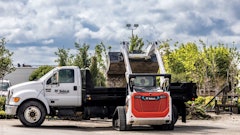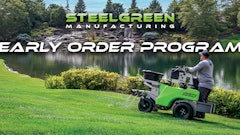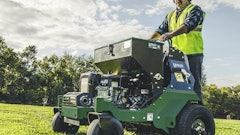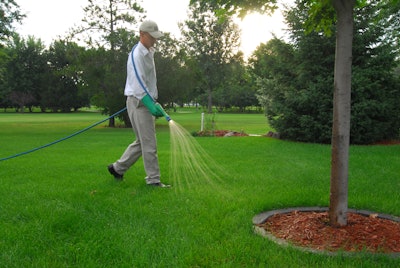
When it comes to using plant growth regulators (PGRs), lawn care operators can take advantage of them in a variety of ways. Dean Mosdell, Ph.D., technical services manager at Syngenta, and Aaron Hathaway, technical services manager at Nufarm, explain how.
Green Industry Pros: How can lawn care companies use PGRs to their advantage?
Aaron Hathaway: So, in lawns, especially if the lawn care operator is doing the mowing and the (chemical) applications to the lawn, they’re doing practices they wouldn’t have to if they could simply slow down the growth of these plants. That’s where PGRs come in because they can simply regulate the growth of any plant. With turfgrass, we can slow down that vertical growth and possibly have to mow less, and even if we’re not mowing less, we’re getting fewer clippings. For growth regulation, PGRs are a great tool.
Dean Mosdell: PGRs can reduce vertical growth, leaf elongation and node extension, resulting in a darker green, more compact plant. This can result in reduced clippings, green waste, mowing time and labor required in the mowing process. With labor constraints, the ability to maintain high-quality turf with less effort can be advantageous to full-service landscapers.
Green Industry Pros: Have you seen an increase in PGR use across lawn care and landscape companies? If so, why?
Hathaway: A PGR can help reduce the growth and proliferation of some of those weeds (such as annual bluegrass). That’s how I’ve seen a lot of lawn care operators use these PGRs to begin with, but they’re learning that they can use them for a lot more than just in lawns.
Mosdell: With the difficulty in finding labor, a PGR program can help reduce labor required to maintain lawns and landscapes. It is not a replacement, but rather a tool that can reduce hand labor requirements in lawn care and landscape maintenance.
Green Industry Pros: What are the benefits of using them?
Mosdell: Faster mowing time, less clippings and greater intervals between mowing can be beneficial to homeowners, as well.
Hathaway: It’s a fairly new practice for a lawn care operator to use PGRs in a lawn to reduce growth, but the benefits are huge. If you could reduce the number of times you mow, especially in the spring, those could pay big dividends to the person doing the mowing.
For lawn care operators that also manage landscapes, bushes and hedges, those are areas that take up a lot of time to trim. That’s where we’ve seen lawn care operators or managers using these PGRs in the past, and they’re huge time savers in that area. The main benefit of reduced growth is to reduce mowing and or reduce the clippings after you mow, so that you’re not going back with a backpack blower or raking up some of those clippings.
There are also a lot of side benefits including reducing the growth of the turfgrass—you don’t lose all the energy the plant would put into vertical growth. Instead, when you make an application, the plant will partition that growth and use it for other processes. Because they’re not spending all that energy in vertical growth, we found that plants will actually use it in other areas, like root growth, tillering or other physiological plant processes that make that plant healthier. We’ll also see an increase in chlorophyll in the plant, simply because it’s not spreading that chlorophyll across taller plants, and instead of growing vertically, they’ll grow laterally. We’re also still finding more benefits in the way of less water use, because plants can store more carbohydrates, producing greener turf.
Green Industry Pros: What do lawn care operators need to keep in mind before using PGR products?
Mosdell: Turf type is important when considering what PGR to use, as well as the correct rate at which to apply it. The lawn must be free of disease and insect issues and actively growing to fully benefit from a PGR application.
Hathaway: There are Class A PGRs, which are fully absorbed early on, and Class B PGRs, which need to be watered in so that the roots of the plants can take it up. Also, different PGRs used at different rates will affect different turfgrass species very differently. We use things like current degree day models to figure out how often we need to reapply these because some PGRs are being broken down faster when it’s warmer outside. The reapplication intervals are a big part of it because if you’re trying to reduce the growth of a plant, you want to consistently reduce the growth of that plant. Getting to that perfect spot is sometimes difficult to figure out because they all work differently on different turfgrass species.


